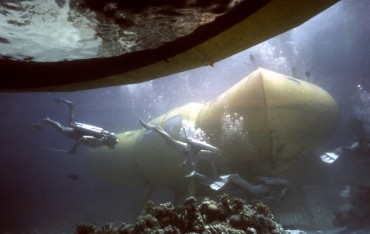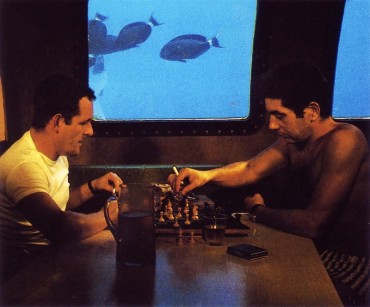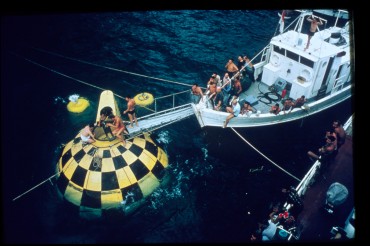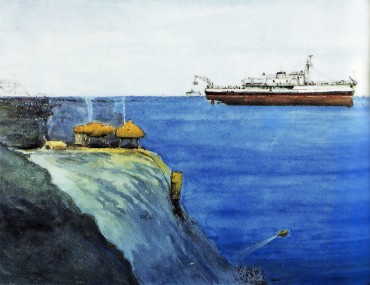The Conshelf odyssey
The year is 1963. On a hot June day in the Red Sea, 30 kilometres offshore of Port Sudan, a strange experience is taking place 10 metres below the surface.
 Amongst multicolour fish and coral, a yellow saucer is slowly and silently rising from the depth to meet what looks like a tiny underwater village. The vehicle uses its headlights to find the entrance of the urchin-shaped garage. Once inside, the two occupants manage to root themselves out of the cabin. One of these divers is named Albert Falco, and the second one is none other than legendary Jacques-Yves Cousteau. They gear up their heavy diving equipment, and get in the water through a shaft at the bottom of the garage. A few strokes of flippers later and they find themselves at the entrance of another underwater metallic structure, resembling a starfish and named “Denise”. On the inside, five divers are busy proving that it is perfectly possible to live and work below the surface of the sea for 30 days in a row.
Amongst multicolour fish and coral, a yellow saucer is slowly and silently rising from the depth to meet what looks like a tiny underwater village. The vehicle uses its headlights to find the entrance of the urchin-shaped garage. Once inside, the two occupants manage to root themselves out of the cabin. One of these divers is named Albert Falco, and the second one is none other than legendary Jacques-Yves Cousteau. They gear up their heavy diving equipment, and get in the water through a shaft at the bottom of the garage. A few strokes of flippers later and they find themselves at the entrance of another underwater metallic structure, resembling a starfish and named “Denise”. On the inside, five divers are busy proving that it is perfectly possible to live and work below the surface of the sea for 30 days in a row.
One of them is lying on a bed, listening to the radio, while another one is having his hair cut. Sitting in a corner, a diver named Claude Wesly delicately opens a pressure canner, and sets a parrot free. The animal, sent by the support boat, will act as a watchdog, or in this case a watchparrot. It will immediately warn the crew in case of pressure problems, much like a canary would warn the workers in a coal mine. Wesly takes the bird for a tour of the habitat, and stops in front of a porthole to point out the various parrot fish that swim around “Denise”. Still today, when watching the movie “The World Without Sun”, viewers mistake it for science-fiction. All these scenes are very real indeed. This experience took place 51 years ago, and was imagined by Cousteau. He named it “Precontinent II”, or “Conshelf II” in English.
 It’s such an incredible expedition that the crew decided to film their life in the habitat. When the movie hit the theatres in 1964, it was an overnight success. Hollywood rewarded the film a year later, and awarded it the Oscar of best documentary in 1965. In a few months, the French became international superstars of the underwater exploration, thanks to Cousteau and his red hat.
It’s such an incredible expedition that the crew decided to film their life in the habitat. When the movie hit the theatres in 1964, it was an overnight success. Hollywood rewarded the film a year later, and awarded it the Oscar of best documentary in 1965. In a few months, the French became international superstars of the underwater exploration, thanks to Cousteau and his red hat.
“I was lucky enough to be part of all these underwater adventures”, recalls Claude Wesly with lots of emotion. Today aged 84, he was part of the team that Cousteau assembled to accompany him on these missions. “It was as if an astronaut was asked if he was interested in going for a walk on the moon!” he tells us. It is only five years after “Conshelf II”, the 21st of July 1969, that Neil Armstrong will make his lunar footprints.
Back in the sea, the French are not the first men to spend time underwater. The Americans pioneered the idea with their “Man in the Sea” program and got a good head start. But Jacques-Yves Cousteau imagined a technically challenging mission, which will be well publicised: “Conshelf I” took place near Marseille in 1961 and was soon followed by “Conshelf II” in the Red Sea, and “Conshelf III” in 1965 in Saint-Jean-Cap-Ferrat. This last mission will set the bar very high, the aim being to know if men could live and work at great depths. To verify his theory, Cousteau built a metallic sphere of 5,70 metres in diameter that was weighted at a depth of 110 meters on a rectangular chassis of 14 by 8 metres. Six aquanauts were asked to live in this habitat for three weeks. Not only will they succeed, but they will go a step further in taking care of a drill head, just to prove that it was possible to perform precise tasks at such a great depth. The achievement is historical.
 When asked if he thought today that these missions were very risky for his team and him, Claude Wensly answers: “With Cousteau, nothing was left to chance. We didn’t have any interrogation whatsoever. It didn’t occur to us that the outcome would be anything but successful, because we were surrounded by the right people.”
When asked if he thought today that these missions were very risky for his team and him, Claude Wensly answers: “With Cousteau, nothing was left to chance. We didn’t have any interrogation whatsoever. It didn’t occur to us that the outcome would be anything but successful, because we were surrounded by the right people.”
At the time, Cousteau had indeed assembled a team of experts in each domain, in order to secure the technical difficulties. But more importantly, they were great at brainstorming ideas for future missions. Since this golden age of underwater habitat, many projects, although pertinent, have sunken into collective oblivion.
The 1962 program “Floating Island” is one example out of many. In front of Nice in the French Riviera, Cousteau invented a floating habitat 60 metres tall. This metallic tube, whose three quarters were submerged, was anchored to the seafloor with a chain. At the top above the water, a little house was equipped with showers, kitchen, helicopter platform, and enough room to accommodate 4 researchers. In order to observe what happened under the surface, the aquanauts could simply take the elevator.
 Although incredible and futuristic, these projects were purely and simply abandoned by Cousteau after “Conshelf III”. Underwater habitat research was brought to a stop, almost overnight.
Although incredible and futuristic, these projects were purely and simply abandoned by Cousteau after “Conshelf III”. Underwater habitat research was brought to a stop, almost overnight.
“Cousteau had proven that it was possible, tells us Claude Wesly. He decided to focus on some other things…”
Such is the official version of the story. In reality, Cousteau was desperately searching for help to finance his programs. Not finding the financial support he needed in France, he decided to go to America. As a result of the interest in his cinematographic hits, the ABC television network accepted a contract of more than 4 million dollars with Cousteau. It’s the beginning of the memorable TV show “The Undersea World of Jacques Cousteau” that several generations enjoyed every weekend.
The French oceanographer architect Jacques Rougerie was amongst the show’s very first loyal fans. “The first time I watched the movie “The Silent World” I had a revelation, recalls the man who has his office on a barge right next to the Place de la Concorde in Paris. I was studying architecture at the same time as Cousteau began his projects of underwater habitats. His force was his ability to show the public that the seas and oceans weren’t a large mass of inert water. When watching the famous scene where the divers descended into the depths with their torches, a world that is an explosion of colours and life was revealed to us. It is then that I decided to mix architecture with oceanography. For me, it felt right!”
 Rougerie manages to identify one of the key elements of the absolute disregard when it came to research on underwater habitat in France, and why all these projects were abandoned before they had a chance to prove their utility. This element, it is the cultural image that we had of the seas and oceans.
Rougerie manages to identify one of the key elements of the absolute disregard when it came to research on underwater habitat in France, and why all these projects were abandoned before they had a chance to prove their utility. This element, it is the cultural image that we had of the seas and oceans.
“Today, we can see how easy it is for the young to understand and master the marine codes, explains Rougerie. Since an early age, they learn to enjoy and even love the ocean, through nautical and aquatic sports. Just look at the number of water sports that are available these days! We shouldn’t forget that in the past, the sea had a really negative reputation. Its image was often associated with things such as pain, death etc. Vessels that sink, fishermen that disappear at sea, sea monsters, the waters that become black and menacing when a storm is coming in, are just a few of the examples of how we were used to see these huge masses of water. Of course, this popular perception reached its pinnacle with the 1975 movie “Jaws” by Steven Spielberg. Still today, it is hard to realise how bad this film was for the reputation of the sea, and what it did to the collective unconsciousness. Suddenly, everybody was afraid of what could be there. It was the worst possible scenario.”
Rougerie knows what he is talking about, he drew and designed many marine exploration vessels as well as underwater habitats in the 80’s (which we will study in further chapters). Each and every time, he encountered scientific reticence and misunderstanding coming from the French authorities. One reason was that these habitats were creating an unclear legal situation. “To my regret, I found out that in France you were put in front of the firing squad for expressing such ideas. I was taken for a demented, and it happened for every one of my projects. I feel that in France, it is the mentality that forbids good ideas to blossom.”
Although Cousteau proved to create international success with his futuristic mission, the political will in France kept on systemically refusing to look into the possibility to colonise the seas. Lacking the public and private money, France missed the opportunity to keep researching the subject and position itself as a pioneer such as the United Stated did with its space program and are now inextricably linked in history.
 In the Red Sea, just off the coast of Sudan, sharks are peacefully swimming around the abandoned ruin of what once was the underwater habitant “Conshelf III”. This metallic wreck is slowly disappearing, silently swallowed by an all-powerful nature… and an aging misunderstanding.
In the Red Sea, just off the coast of Sudan, sharks are peacefully swimming around the abandoned ruin of what once was the underwater habitant “Conshelf III”. This metallic wreck is slowly disappearing, silently swallowed by an all-powerful nature… and an aging misunderstanding.
The 3rd chapter of our investigation will be published friday the 27th of June 2014.
NOTA © The cover photo was taken by Stephen Frink



